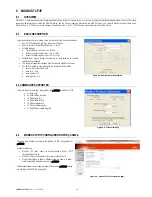
pCOWeb
+030220966 – rel. 1.1 – 12.12.2017
47
9.6
CONFIGURING FROM pCO SYSTEM MASKS
Starting from Bios 5.17, it is possible to configure communication parameters accessing pCO system
masks. Configuration using system masks is intended for first installation and allows to set network
(Ethernet/BACnet) parameters, other parameters (alarms, events, etc.) must be configured with usual
procedures. Configuration via system masks can be done both using Carel and Modbus protocols, but is
limited to BMS1 serial port. In order to properly visualize and change parameters, make sure that
pCOWeb
and pCO controller are regularly communicating. Masks can be accessed by pressing the
keys ALARM+ENTER at the same time for a few seconds:
To access the specific masks, the following steps must be executed:
PCOWEB/NET CONFIG:
Successively, to configure a
pCOWeb
, the choice “PCOWEB SETTINGS”
must be selected:
The following mask will be shown:
In a few seconds, if communication between
pCOWeb
and
pCO
controller is properly working, the fields will fill up wth current parameters. In case fileds were
not filled with current values, it is needed to check Bios firmware version and the protocol on BMS serial.
At this point, it is possible to proceed with parameters change, selecting the required field using the ENTER key and setting the desired value with UP/DOWN
keys. If the DHCP option is set to ON, it is not possible to change IP address and Netmask fields. Pressing the ENTER key repeatedly, all available
parameters can be visualized, listed as in the following:
Once parameters have been chosen, it is possible
to update them, setting the following mask to YES
and pressing ENTER.
During parameters settings, the following notice will
be shown:
At the end of the operation:
Finally, it is needed to access
pCOWeb
and proceed with reboot, when rebooted new parameters will be properly set on device.
9.7
PLUGINS
Plugins are auxiliary applications that can be installed on
pCOWeb
and allow custom functions to be added easily and automatically.
There are two types of Plugins:
•
distributed by CAREL, available at
http://ksa.carel.com
.
•
custom, created for a specific application.
To be able to create a Plugin, good knowledge is required of the GNU/Linux operating system and bash scripting and, to create compiled binary files, these
need to adhere to certain requirements. The rules for creating Plugins are summarised in APPENDIX I on page 79.
9.7.1
Installing a Plugin
Access the
pCOWeb
main configuration page (see 9.2 on page 41), then open the Plugin page (
Figure 9.m
).
No plugins found: indicates that no plugin is currently loaded.
Plugins found: lists the Plugins currently installed that have at least one HTML configuration page.
Figure 9.m - Installing / uninstalling the Plugins






























